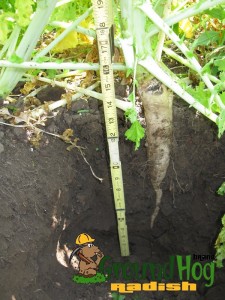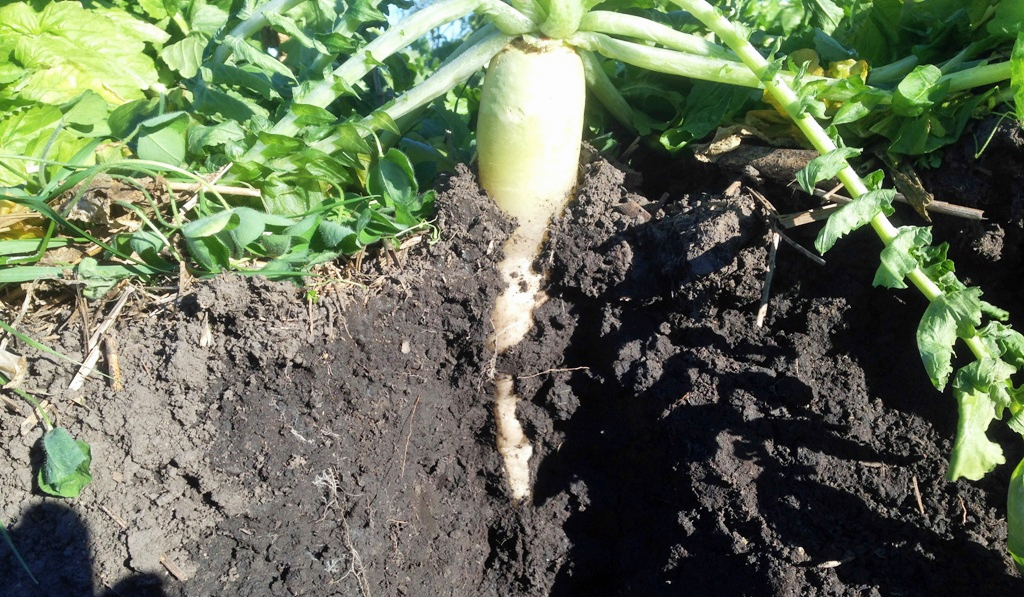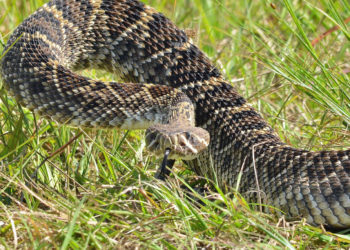As all farmers and ranchers know, when it comes to crop and land management, the smartest, and often the most successful, are the men and women who have done their homework and utilize their land in a way that will continue to build the soil while being able to make a profit on their cash crops or to provide nutritional forage for their livestock. Everyone who has farmed for any length of time has a system in place that works, though whether or not it is the best system is up to the individual and his or her measurable results.
 That brings us to the subject of GroundHog Radish. Grown as a cover crop in late summer or early fall, Groundhog Radish will quickly grow a closed canopy a full month before oat and rye cover crops, effectively blocking the sun from and aiding in weed suppression during the fall weed season. Weed suppression in the fall means fewer weeds in the spring! In addition Groundhog Radish produces more root mass than mustard crops or oil seed radish and has 2 to 4 times the number of roots as rye or rape grasses, enabling it to effectively mine nitrogen and other nutrients, that might otherwise leach down and out of the soil, back to the surface where your spring crops will receive the most benefit, reducing or eliminating the need for supplemental nitrogen.
That brings us to the subject of GroundHog Radish. Grown as a cover crop in late summer or early fall, Groundhog Radish will quickly grow a closed canopy a full month before oat and rye cover crops, effectively blocking the sun from and aiding in weed suppression during the fall weed season. Weed suppression in the fall means fewer weeds in the spring! In addition Groundhog Radish produces more root mass than mustard crops or oil seed radish and has 2 to 4 times the number of roots as rye or rape grasses, enabling it to effectively mine nitrogen and other nutrients, that might otherwise leach down and out of the soil, back to the surface where your spring crops will receive the most benefit, reducing or eliminating the need for supplemental nitrogen.
Besides the benefits mentioned above, the size and depth of the root system on Groundhog Radish effectively aerates the soil, alleviating soil compaction, as well as promoting better water filtration, a definite plus when it comes to your spring and summer crop or forage performance, especially with the drought conditions we’ve seen increasing over the last couple of years. The University of Maryland conducted a study to measure the amount of nitrogen captured before winter killing of Groundhog Radish occurred. Groundhog Radish will capture 150 to 200 pounds of nitrogen per acre! That is nitrogen you will not have to apply chemically, saving a lot of time and money. The beneficial root system will also reduce tillage; again a valuable money and time saver.
 Groundhog Radish can be planted with other grasses should be used in rotation with other species as part of your land management plan. In the northern climes, you will want to seed in August, while the southern climes can wait until September, seeding at a rate of 10 to 12 pounds per acre. The seed can be broadcast or planted 1/4-inch deep if drilled. It is suggested you apply 60 units of nitrogen for the optimal root growth. Be aware that Groundhog Radish doesn’t do well in spots that stay wet and will winter kill when temperatures drop into the teens. Allowing at least one month of growth, with the optimal growth time being at least 60 days, tilling the radish cover crop will start the decomposition process, making the mined nitrogen and other essential nutrients available for your spring and summer crops.
Groundhog Radish can be planted with other grasses should be used in rotation with other species as part of your land management plan. In the northern climes, you will want to seed in August, while the southern climes can wait until September, seeding at a rate of 10 to 12 pounds per acre. The seed can be broadcast or planted 1/4-inch deep if drilled. It is suggested you apply 60 units of nitrogen for the optimal root growth. Be aware that Groundhog Radish doesn’t do well in spots that stay wet and will winter kill when temperatures drop into the teens. Allowing at least one month of growth, with the optimal growth time being at least 60 days, tilling the radish cover crop will start the decomposition process, making the mined nitrogen and other essential nutrients available for your spring and summer crops.
As always, we welcome any comments and additional information our customers can provide. We strive for the success of all of our customers, from our hardworking backyard gardeners to our industrious farmers and ranchers.
Happy Gardening and Successful Farming from all of us at GrowJoy.





7 Comments
Bobbie O'Brien
August 26, 2014 at 12:22 pmDefinitely true. I use this method and it works. I had one cantaloupe that weighed 10 lb 6 oz.
jstutzman
August 27, 2014 at 8:17 amBobbie: Thanks for your feedback on GroundHog Radish! Hope you have a bountiful harvest this season. GHS
Jackie Welch
August 26, 2014 at 3:44 pmHello,
I have flower beds and the largest one was built on very compacted soil. In the last 6 years I have added quite a bit of compost. The soil is fairly loose down to about 6-8 inches, BUT, my flowers are not growing or blooming very well. Would this method work for me to not only loosen the soil but enrich it too? I would be willing to try it.
Thank you,
Jackie
jstutzman
August 27, 2014 at 8:16 amJackie: GroundHog Radish would work great for breaking up your flower bed soil. You will notice such a difference that you will want to do it every year! Good luck. GHS
Sara
August 27, 2014 at 11:00 amI have the dreaded Canadian thistle and have been trying to kill them for a few years now and of course they keep coming back. Would the radish work for eradicating the thistle?
jstutzman
August 27, 2014 at 1:15 pmSara: GroundHog Radish would help with thistle as long as you tilled the ground before planting the radish seed.
Sara
August 27, 2014 at 11:04 amP.S. I have mostly perennials and a few bushes in my garden